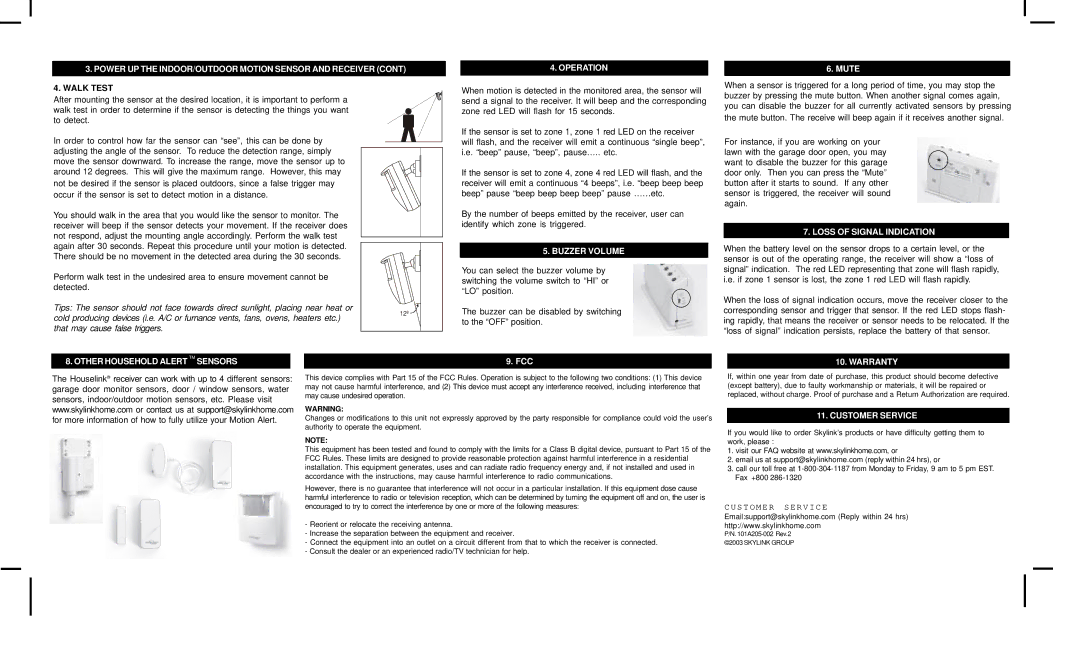3.POWER UP THE INDOOR/OUTDOOR MOTION SENSOR AND RECEIVER (CONT)
4.WALK TEST
After mounting the sensor at the desired location, it is important to perform a walk test in order to determine if the sensor is detecting the things you want to detect.
In order to control how far the sensor can “see”, this can be done by adjusting the angle of the sensor. To reduce the detection range, simply move the sensor downward. To increase the range, move the sensor up to around 12 degrees. This will give the maximum range. However, this may
not be desired if the sensor is placed outdoors, since a false trigger may occur if the sensor is set to detect motion in a distance.
You should walk in the area that you would like the sensor to monitor. The receiver will beep if the sensor detects your movement. If the receiver does not respond, adjust the mounting angle accordingly. Perform the walk test again after 30 seconds. Repeat this procedure until your motion is detected. There should be no movement in the detected area during the 30 seconds.
Perform walk test in the undesired area to ensure movement cannot be detected.
| Tips: The sensor should not face towards direct sunlight, placing near heat or | 12º |
| cold producing devices (i.e. A/C or furnance vents, fans, ovens, heaters etc.) |
| |
| that may cause false triggers. | |
4. OPERATION
When motion is detected in the monitored area, the sensor will send a signal to the receiver. It will beep and the corresponding zone red LED will flash for 15 seconds.
If the sensor is set to zone 1, zone 1 red LED on the receiver will flash, and the receiver will emit a continuous “single beep”, i.e. “beep” pause, “beep”, pause….. etc.
If the sensor is set to zone 4, zone 4 red LED will flash, and the receiver will emit a continuous “4 beeps”, i.e. “beep beep beep beep” pause “beep beep beep beep” pause ……etc.
By the number of beeps emitted by the receiver, user can identify which zone is triggered.
5. BUZZER VOLUME
You can select the buzzer volume by switching the volume switch to “HI” or “LO” position.
The buzzer can be disabled by switching to the “OFF” position.
6. MUTE
When a sensor is triggered for a long period of time, you may stop the buzzer by pressing the mute button. When another signal comes again, you can disable the buzzer for all currently activated sensors by pressing
the mute button. The receive will beep again if it receives another signal.
For instance, if you are working on your lawn with the garage door open, you may want to disable the buzzer for this garage door only. Then you can press the “Mute” button after it starts to sound. If any other sensor is triggered, the receiver will sound again.
7. LOSS OF SIGNAL INDICATION
When the battery level on the sensor drops to a certain level, or the sensor is out of the operating range, the receiver will show a “loss of signal” indication. The red LED representing that zone will flash rapidly, i.e. if zone 1 sensor is lost, the zone 1 red LED will flash rapidly.
When the loss of signal indication occurs, move the receiver closer to the corresponding sensor and trigger that sensor. If the red LED stops flash- ing rapidly, that means the receiver or sensor needs to be relocated. If the “loss of signal” indication persists, replace the battery of that sensor.
8. OTHER HOUSEHOLD ALERT TM SENSORS
The Houselink® receiver can work with up to 4 different sensors: garage door monitor sensors, door / window sensors, water sensors, indoor/outdoor motion sensors, etc. Please visit www.skylinkhome.com or contact us at support@skylinkhome.com for more information of how to fully utilize your Motion Alert.
9. FCC
This device complies with Part 15 of the FCC Rules. Operation is subject to the following two conditions: (1) This device may not cause harmful interference, and (2) This device must accept any interference received, including interference that may cause undesired operation.
WARNING:
Changes or modifications to this unit not expressly approved by the party responsible for compliance could void the user’s authority to operate the equipment.
NOTE:
This equipment has been tested and found to comply with the limits for a Class B digital device, pursuant to Part 15 of the FCC Rules. These limits are designed to provide reasonable protection against harmful interference in a residential installation. This equipment generates, uses and can radiate radio frequency energy and, if not installed and used in accordance with the instructions, may cause harmful interference to radio communications.
However, there is no guarantee that interference will not occur in a particular installation. If this equipment dose cause harmful interference to radio or television reception, which can be determined by turning the equipment off and on, the user is encouraged to try to correct the interference by one or more of the following measures:
-Reorient or relocate the receiving antenna.
-Increase the separation between the equipment and receiver.
-Connect the equipment into an outlet on a circuit different from that to which the receiver is connected.
-Consult the dealer or an experienced radio/TV technician for help.
10. WARRANTY
If, within one year from date of purchase, this product should become defective (except battery), due to faulty workmanship or materials, it will be repaired or replaced, without charge. Proof of purchase and a Return Authorization are required.
11. CUSTOMER SERVICE
If you would like to order Skylink’s products or have difficulty getting them to work, please :
1.visit our FAQ website at www.skylinkhome.com, or
2.email us at support@skylinkhome.com (reply within 24 hrs), or
3.call our toll free at 1-800-304-1187 from Monday to Friday, 9 am to 5 pm EST. Fax +800 286-1320
CUSTOMER SERVICE
Email:support@skylinkhome.com (Reply within 24 hrs)
http://www.skylinkhome.com
P/N. 101A205-002 Rev.2 ©2003 SKYLINK GROUP

